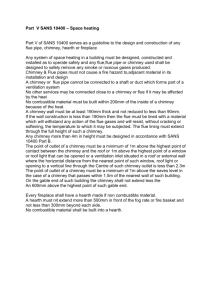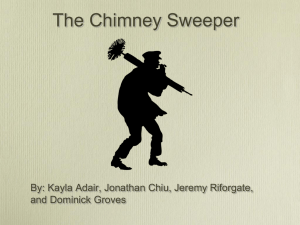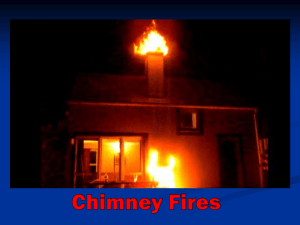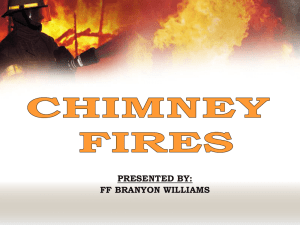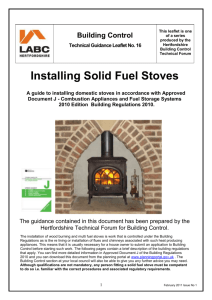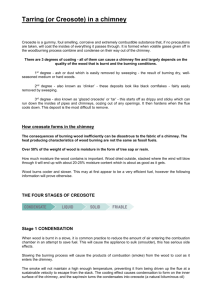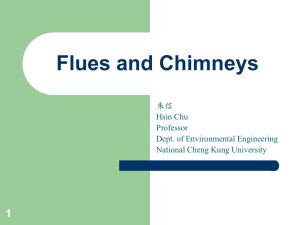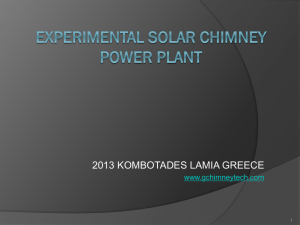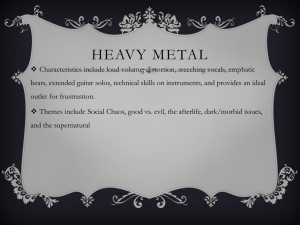Chimney Fires
advertisement
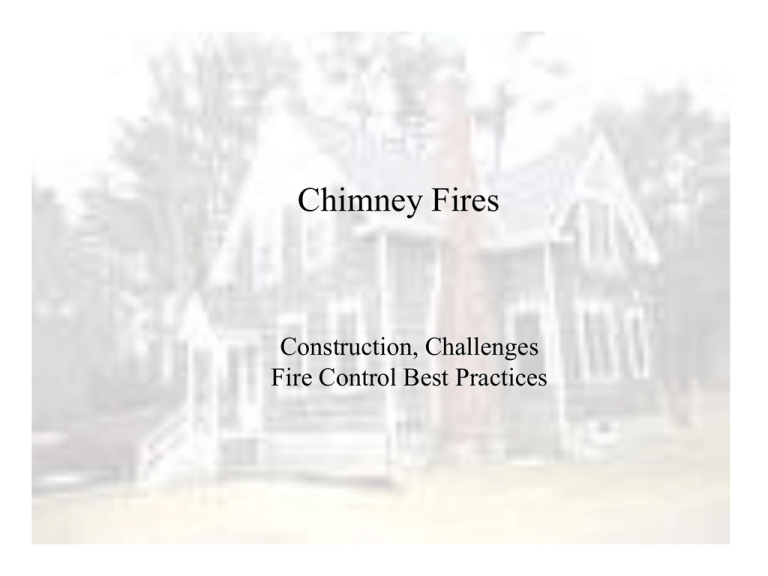
Chimney Fires Chimney Fires Construction, Challenges Fire Control Best Practices Objectives • Review different types of chimney construction • Identifying lines vs. unlined flues • Understand fire spread characteristics of most common chimney types • Effective fire control practices Chimney Construction • The chimney method of smoke removal has been around for centuries • Early man discovered the benefits of vertical draft methods in removing smoke from caves, huts, etc. Chimney Construction (cont.) • Various means to construct vertical drafts (chimneys) used: – – – – – Stone Mud/sticks Hollow logs Bricks Metal (modern) Attachment Methods • • • • • Interlock wall stones with chimney stone Free-standing Wall logs interlocked in stone or brick Metal ties to wall framing (20th century) Metal bracing within wood framework (modern zero-clearance chimney piping) Lined Flue • Inside of chimney construction contains flue “pipe” or “lining” that minimizes openings, joints, or crevices along vertical path of heat, smoke, embers Metal Chimney Liner Tile Chimney Liner Liner Characteristics… • Each type of liner has it’s benefits and drawbacks… – Metal is expensive, but crack resistant and often installed in one piece top-to-bottom. – Most common sizes are 6- and 8- inch – Easy connection to wood/coal stoves – Can be routed through some twists and turns – Can retrofit old, unlined flues Liner Characteristics (cont.) • Tile, or terra cotta, offer wider passages than metal and are less expensive than metal • Not used in retrofits or relining of existing flues • Susceptible to temperature extremes and settling of foundations, causing cracking • May consist of several joints Zero-Clearance or Prefabricated Metal Chimney Flues • Developed nearly 25 years ago to service the growing alternative heating market • Consist of multiple layers of stainless steel separated by fireretardant insulation Unlined Flues • Found in many homes built prior to 1930 • May be of stone or brick construction Unlined Flues (cont.) Fire Spread Characteristics Tile/Terra Cotta Liners • Cracks appearing over time and temperature extremes provide openings for hot ash/embers to exit the flue and contact adjacent combustible framing members • May also provide path into void spaces, carrying sparks into area containing combustibles (attic, behind knee wall) Terra Cotta/Tile Liner (cont.) • Subject to degradation from rain, ice, snow • Mechanical damage from improper cleaning, previous fires • Damage introduced from exterior forces (wind, trees) Metal Chimney Liners • May warp from extremes in temperature (burning stove too hot) • Improper attachment of flue sections Metal Flues (cont.) • Joints may be open, allowing sparks and embers to escape into void and combustible spaces adjacent to chimney, permitting fire spread and slow detection of same. • Stainless steel tubular liners are used in older unlined retrofitting, often resulting in turns and twists permitting build up of creosote and animal nests. Creosote Buildup • Creosote is a byproduct of INCOMPLETE combustion. • Adheres to tile, unlined, flexible metal, and joints in flue liners Creosote (cont.) • Relatively cool temperatures in upper portion of flue condense products of combustion into potential “time bombs” on liners. • Can be minimized by burning proper fuels (seasoned wood) at proper temperature recommended by stove/fireplace manufacturer Animal Nest in Chimney Flue Retrofitting Unlined Flues • It is common to find older, unlined chimneys outfitted with new style flexible, stainless steel tubular liners • Often connect to wood stove or insert • May be placed in unlined flue surrounded by fire-resistant material such as a vermiculite/gypsum mix Prefabricated Metal Chimneys • Have Class “A” fire rating and may be used inside of wooden box framing according to building codes and Underwriter’s Laboratories test results • Lock together in a twisting motion • Are NOT fire PROOF!!! Identifying Fire Presence and Control Options Caller Complaints • Hear persistent “roaring” sound from upper flue area • Smoke from chimney when no active fire in fireplace/ stove • Haze/smoke odor in upper floors of house and/or attic • Walls adjacent to chimney hot to touch Fire Control Tactics • Thermal Imager A MUST!!!! • Get personnel ABOVE and BELOW fireplace/stove-check walls, floor space adjacent to flue--attic • Check flue clean out (if present) • Roof crew to check openings at top Tactics (cont.) • Remove active fire from firebox • Closely monitor flue for active flames • Consider use of dry chemical extinguisher or “chimney bombs” (dry chem in plastic baggies dropped from top of chimney) • Pressurized water extinguisher and/or preconnect should be LAST RESORT • Once fire controlled, occupant must be directed to have licensed chimney sweep clean and inspect chimney PRIOR to ANY additional usage. • Officer should document this on NFIRS report. Points to Consider… • Successful control of chimney fires requires time and patience • Continual monitoring of all adjacent combustible areas required during operations • Older, unlined flues often contain structural framing members tying chimney to house Other Important Considerations… • EARLY laddering of roof • Use of chimney chains to clear flaming creosote (if available on scene) • Aggressive investigation of adjacent void spaces • Identification of lined vs. unlined flue Summary • Firefighters should be familiar with the various chimney types • Understand particular hazards of each type of flue • Recognize signs of active fire situations in flue and execute proper control methods Summary (cont.) • Make every attempt to control fire while minimizing damage to chimney/flue structure • Ensure safe operations when working in poor lighting and on wet/icy or steep roof pitches • Have a safe, happy, injury- and fire-safe holiday season!!!!!
